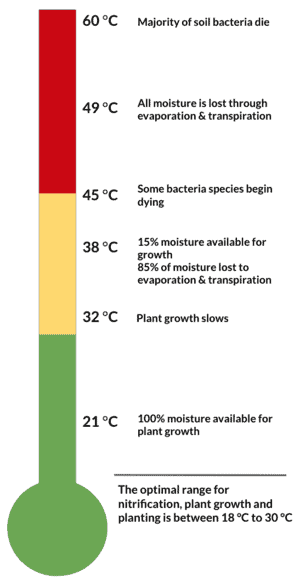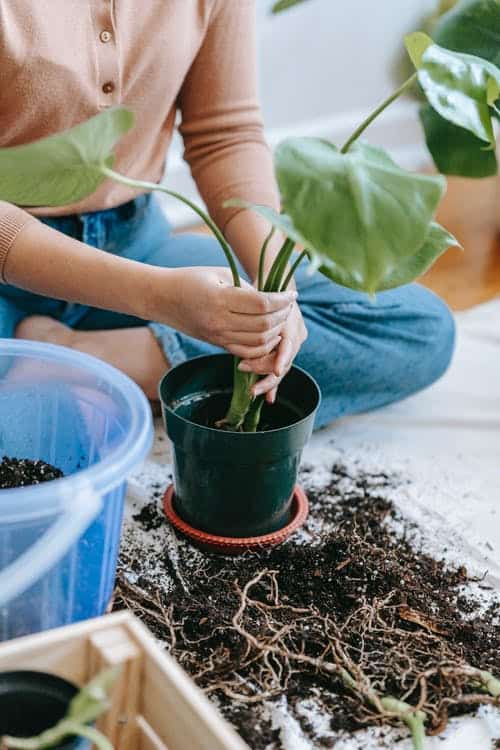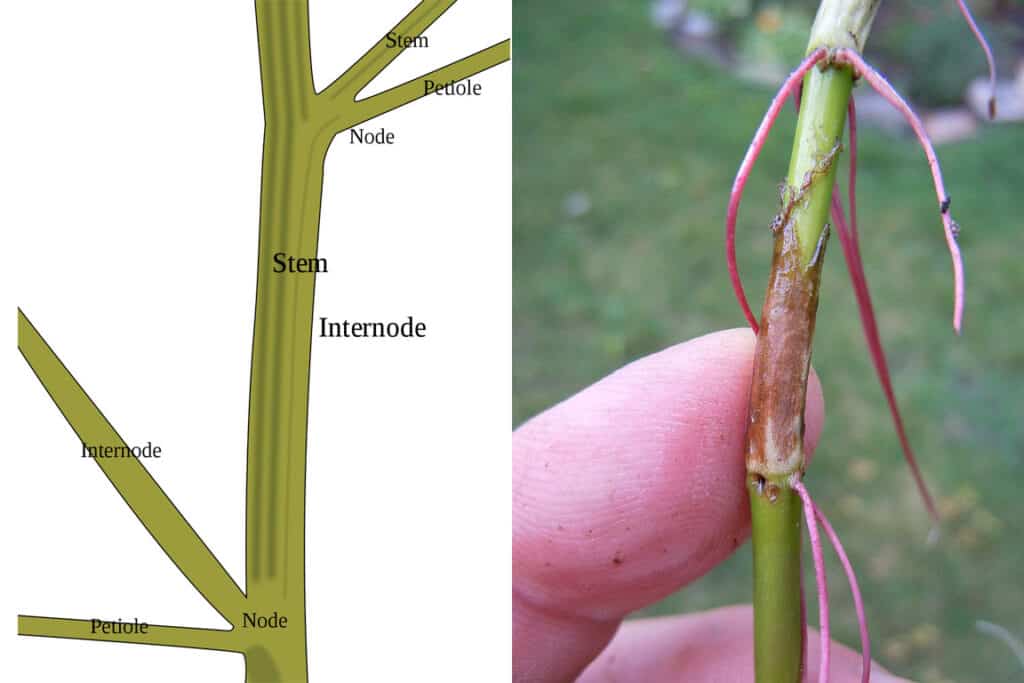If you wish to grow a rare tropical houseplant that is easy to maintain and boasts gorgeous large leaves, then Rhaphidophora Pertusa is your answer!
The rare climbing plant quickly grows over 10 feet and boasts signature split leaves that can reasonably compete with Monstera or Philodendrons.
Moreover, it does well in an average home environment with minimal care requirements.

However, ensure to keep them away from dropping temperatures and compact soil mix that will push back the growth.
Follow this guide to learn where to find these gorgeous plants, complete the plant care guide, and learn how to diagnose and treat many problems.
Table of Contents Show
Overview of Rhaphidophora Pertusa
Rhaphidophora Pertusa is a climbing species native to the tropical climate of the Indian subcontinent.
You would find them in their natural state in the Andaman Islands, India, Myanmar, Maldives, Sri Lanka, Thailand, and Bangladesh.

However, directly consuming the plant may cause mild to severe toxicity in humans and pets.
Here is a brief guide about the plant.
| Indicator | Identity |
|---|---|
| Scientific Name | Rhaphidophora pertusa (Roxb.) Schott |
| Other name | Monstera pertusa, Scindapsus pertusus, Pothos pertusus |
| Native | Indian Subcontinent |
| Family | Araceae |
| Genus | Rhaphidophora |
| Growth Zone | USDA zone 11a-12 |
| Plant Type | Tropical Climber |
| Growth Size | 8-20 inches (20-50cm) tall and 6-10 inches (15-25 cm) wide |
| Growth Rate | Moderate to Fast |
| Foliage | Irregular Pinnatified (split) leaves |
| Blooming Period | Throughout after maturity |
| Flowering and fruits | Spadix flower and many-seeded berries |
| Toxicity | Toxic to both humans and pets |
| Common Pests | Mealybugs, scale, spider mites, whiteflies, and thrips |
| Horticultural Diseases | Root rot, bacterial leaf spots, and blights |
Where to Buy Rhaphidophora Pertusa?
You can easily buy young or matured Peperomia Pertusa plans from local nurseries, specialist growers, and online retailers.
Here is a list of a few dedicated online sellers with Rhaphidophora pertusa for sale.
| Places to Buy | Delivery Service |
|---|---|
| Etsy | Delivery within 5 to 7 days |
| Plant Buys | Shipping may take 3-4 weeks |
| Aroid Sale | Shipping will take a few days |
| Exclusive Plants | Shipped within a few business days |
Rhaphidophora Pertusa – Ultimate Grow & Care Guide
Rhaphidophora Pertusa makes a great houseplant that attains a great size with magnificent leaves.
A pantropical plant, you should try mimicking closest to the tropical environment.
Here is a brief care guide for Rhaphidophora Pertusa.
 12 hours of bright filtered sunlight |  Once a week in spring and summer Once in two weeks in fall and winter |
 Well-draining, nutrient-rich potting mix pH level: 6.0-7.0 |  Diluted balanced fertilizer Once in spring and summer |
 70 to 80°F (21-27 C) |  40-50% of humidity |
 Every year in spring or early summer |  Propagate via stem cutting and air-layering |
1. Bright Indirect Sunlight
Rhaphidophora Pertusa thrives in a brightly lit location, preferably dappled, filtered sunlight.
They are best kept in the east-facing window that gets ample morning sunlight and shades the rest of the day.

Otherwise, consider placing the plant 4-5 feet away from the south or west-facing windows with a day-long filtered sunlight supply.
One way to tell your plant is not receiving enough sunlight is leggy growth with more petite foliage.
Other signs of the light-stressed plant include:
- Dull and stunted growth
- Yellowing of leaves
- Loss of green pigments from the leaves
- Dropping and limping leaves
On the other hand, direct sunlight will lead to transpiration (loss of water from the leaves) and sickly plants indicated by these signs.
- Dry and crispy leaves
- Brown patches along the leaf edges
- Loss of color and variegation from the leaves
- Curled leaves

Tips Ensure Optimal Light Intake for Rhaphidophora Pertusa
- Place the plant in an east-facing window to get soft morning light.
- When placing them in the shade, ensure the location gets low to moderate indirect sunlight each day.
- Stop shifting the plant from one location to another to prevent uneven growth.
- A patio, entrance, window, or greenhouse are suitable spots around the house.
- Consider rotating the plant in the same location every few weeks to ensure optimal sunlight intake.
- Alternatively, consider growing it under appropriate light for at least 12 hours.
2. Regular Watering
One of the critical care requirements of Rhaphidophora Pertusa includes regular watering.
They love moist but soggy soil that helps their roots get ample moisture and beneficial macronutrients.

Remember, overwatered Rhaphidophora will run the risk of root rot. Some of the visible signs of an overwatered Rhaphidophora include:
- Yellowing leaves with the limp appearance
- Brown patches on Leaves
- Mold growth
- Shriveled and mushy appearance
- Curling leaves
Immediately cut back on watering and inspect root rot by checking for dark, mushy, or smelly roots.
On the other hand, underwatered plant is indicated by greyish soil, yellowing spots on the leaves, curling leaves, and a crispy appearance.
Treat an underwatered plant by immediately watering or running the pot underwater until the excess oozes out of the drainage holes.
Tips to Ensure Adequate Watering for Rhaphidophora Pertusa
- Check to see if the top layer of soil has dried out.
- Water your Rhaphidophora Pertusa until the water runs clear.
- Wait until the water stops dripping completely.
- Place the Rhaphidophora Pertusa container back in the sun.
- Water your Rhaphidophora Pertusa once a week during the growing season and twice a week during the summer when temperatures exceed 85 degrees Fahrenheit.
- Before continuing or deferring watering, use a soil moisture meter to examine the soil condition.
- Check to see whether any water has accumulated in the tray. To keep the plant from standing in water, empty the tray.
- In the summer, mist the plant leaves to avoid transpiration.
- Reduce watering and look for root rot in an overwatered plant until it recovers.
- Consider bottom watering it or laying the container on a pebble tray filled with water for an underwatered plant.
Pro Tip: The goal with Rhaphidophora Pertusa is never to allow the root ball to dry out or become waterlogged.
3. Warm Temperature and Optimal Humidity
Remember, Rhaphidophora is a tropical genus requiring slightly warmer temperatures than most household plants.
Therefore, the ideal places to plant your Rhaphidophora would be in USDA zones 11a to 12 (40-50°F).
However, it can still grow well in the range of 55-85°F (12 – 29°C) found in most households.

Remember to keep them away from cold drafts, heat stress, or sudden temperature changes, pushing back the plant’s growth.
Anything under 40% will lead to excess transpiration (water loss from the leaves). On the other hand, excess humidity may significantly push the risk of fungal and bacterial infection.
Remember to check for these signs to determine whether the temperature and humidity falter.
| Too Low Humidity | Too High Humidity |
|---|---|
| Wilting and shriveled Leaf | Stems and leaves rot |
| Yellowing of leaves edges | Patches of grey mold on the leaves |
| Brown leaf tips | Fungal growth |
| Leaves may fall in severe conditions | Mold presence in the soil and flower as well. |
Tips to Maintain Ideal Temperature and Humidity
- Find an ideal spot around the house that receives significantly higher indirect sunlight and humidity, such as close to a window near the bathroom or kitchen.
- Avoid placing them close to the air conditioner or heater to avoid extreme temperatures.
- Use a frost blanket or clear plastic bag to cover the plant when the danger of cold drafts is severe, especially in late fall or winter.
- Keeping them under appropriate grow light in fall and winter will help compensate for the lack of indirect sunlight.
- Keep all the houseplants together to help attain optimal humid conditions.
- Consider misting the leaves in spring and summer using the plant mister.
- Otherwise, add a room humidifier or humidifying tray (pebble and water tray).
- Use a hygrometer to determine the humidity level at all times.
4. Organic, Airy Potting Mix
The correct potting mix for an aroid like Rhaphidophora Pertusa is aerated, light, and organic-rich.
The perlite and bark chips ensure the soil mix remains porous to let out excess water and allow air to circulate throughout the container.
Similarly, it does well in a slightly acidic, neutral soil mix with a 6.1-6.5 pH to help roots obtain nutrients more efficiently.
How to Prepare an Ideal Rhaphidophora Mix?
Here are a few typical mixes for Rhaphidophora Pertusa.
- Mix an equal proportion of standard peat and coco coir or peat moss with pearlite (pumice, cocoa husks, orchid bark).
- Make a balanced mix with regular potting soil, perlite, peat moss, coco coir, and horticultural charcoal.
- Add 40% peat moss or coco coir with 30% perlite, 220% bark chips, and 10% compost.
You can rely on the following items.
- Hoffman Spahgnum peat moss
- Miracle-Gro Perlite
- Orchid bark to improve drainage

Note: The exact mix does not matter until it is well-draining, fertile, and airy.
5. Regular Fertilization
Although a fast grower, you can help boost Rhaphidophora’s vertical growth and split leaves by adding fertilizer regularly in the growing season.
You heard it right! Rhaphidophora Pertusa enjoys regular fertilization every 2-3 weeks or once a month in spring and summer.
They are not overfeeders; hence, excessive fertilizer will lead to the buildup of mineral salts in the soil.
Overfertilization is often indicated by slowed growth, brown roots, brown leaf patches or yellowing, and light crumbled soil.
Revive an Overfertilized Rhaphidophora Pertusa
- Run water through the pot to flush out excess salts for 22-30 minutes.
- Immediately cut back on fertilization and let your plant recover.
- In case of severe damage, transplant it to a fresh potting mix and fertilize it only after a month.
- Flush the soil every 3-4 months to prevent salt buildup.
Fertilizer Recommendations for Rhaphidophora Pertusa
Here are a few recommendations for Rhaphidophora Pertusa
- Espoma Company Organic Fertilizer
- Miracle-Gro Indoor Plant Food
- Osmocote Slow-Release Plant Food Plus
- Joyful Dirt Organic-Based Concentrated Food
- Mother Earth Products Nitro Bat Bat Guano
Tips to Apply Fertilizer in Rhaphidophora Pertusa
- Use a balanced liquid-based plant food or nitrogen-rich fertilizer to boost leaf growth.
- Ensure to dilute the liquid solution to half strength (monthly feeding) or ¼ strength (fortnight feeding).
- Apply liquid fertilizer while watering the plant to allow the nutrients easily reach the root system.
- Keep the fertilizer 6 inches away from the plant’s base when applying it to prevent root burns.
- When applying slow-release fertilizer, spread the Osmocote around the plant and water thoroughly.
6. Growth Rate and Pinnatifid (Split) Leaves
Rhaphiophora Pertusa is a robust evergreen that would easily reach 49 feet (15 m) in its native habitat.
However, it will hardly attain 6 feet in height when grown as a houseplant.
It has a terrestrial and epiphytic (growing on other plants) phase, where it will grow as a terrestrial when young and later turn epiphyte.

Ensure to provide support such as a trellis to support the epiphyte’s vertical growth. Since they are vigorous climbers, provide them with a moss pole, totem, or trellis.
However, juvenile leaves do not have splits and are somewhat oval or oblong-elliptic. The leaves will begin developing signature holes and split as it grows bigger.

A single mature leaf would measure 8-20 inches (20-50cm) long and 6-10 inches (12-25 cm) wide.
Regarding flowering and fruits, Rhaphidophora Pertusa will bloom in summer and give out many-seeded berries with oblong seeds.
You would know it is blossoming by its tiny pale orange-colored flower.

7. Annual Repotting
As a vigorous grower, Rhaphiodophora Pertusa would require repotting to a fresh potting mix and larger container every year.
Being a fast grower, it will become rootbound quickly, requiring regular repotting.

Repotting them in the active growing season will ensure the continuous growth of stems and leaves even after repotting,
Steps to Repot Rhaphidophora Pertusa
Here is a step-by-step guide to repotting Rhaphodophora Pertusa.
Step 1: Planter and Potting Mix
Choose a container at least 2-3″ bigger than the previous container, with multiple drainage holes.
Here are a few recommendations.
| Container | Specification |
|---|---|
| Classis Planter (Plastic) | They are durable and lightweight. The drainage holes lie at the bottom |
| LE TAUCI Ceramic Plant Pots | 4+5+6 inch, Set of 3, Planters with holes in the bottom |
| Plastic Planter, HOMENOTE | Comes in five different sizes 7/6/5.5/4.8/4.5 Inch |
Step 2: Remove and Treat the Plant
- Water the plant thoroughly before deciding to repot.
- Once ready, turn the pot sideways and hold it by the stems.
- Tap the bottom of the pot until the plant slides out.
- Massage the root system to remove soil and residue.
- Check the rootball for problems (mushy, black, and dead roots) and trim the affected parts using a pruning shear.
- Apply some fungicides on the cut ends to prevent fungal growth.
Step 3: Transplant the Plant
- Sterilize the pot if you use the same pot, then pour 2/3 layer of potting mix.
- Insert the plant with roots facing down.
- Fill the rest of the pot with the same potting mix and water it thoroughly.
- Place it back in its original location.
8. Pruning and Grooming
A vigorously growing plant requires regular pruning during spring and summer to ensure healthy, even growth.
Regularly prune the plant for dead, damaged, and diseased leaves with a sterilized pruning shear. Similarly, remove leggy stem growth and dead flowers.
Trim close to the stem to control its size. However, avoid cutting over 25% of the plant at any time.
Excessive pruning will lead to a stressed plant with slowed growth.
Pro Tip: Pruning Rhaphidophora Pertusa is the same as pruning a Philodendron or Monstera plant.
Propagating Rhaphiophora Pertusa
You can choose to propagate when your Rhaphidophora Pertusa has attained a good height and is healthy.
There are two ways to propagate Rhaphidophora; stem cutting and air-layering.
1. Propagate via Stem Cuttings
Propagating the herbaceous stem cutting is the easiest way to multiply Rhaphidophora Pertusa.
Here is the step-by-step to propagate the plant via stem cutting.
Step 1: Obtain the Cuttings
- Start with establishing the healthy stems appropriate for cutting, indicated by multiple leaves and nodes and green texture.
- Cut three to four inches of stem with at least two nodes. Ensure to cut below the lower node. One with aerials roots grows faster.
- Snip off the lower leaves but the top two leaves from the stem.

Step 2: Rooting in Water
- Fill a jar or glass with clean, tepid water (chlorine-free).
- Add a few drops of liquid rooting hormone into the water. Next, submerge the stem cutting.
- Place your cutting in a warm location with indirect sunlight and change the water every 3-4 days or when the water level drops.
- The stem cutting should grow feeder roots within 4-6 weeks. Transplant it to a pot when it grows about 3-4 inch long feeder roots.
Step 3: Rooting in Potting Medium
- Take an appropriately sized pot, at least 2-3 inches big, and fill it with peat moss, vermiculite, or coco coir.
- Mix fungicide and rooting hormone to make a paste. Use a spatula or knife to apply the paste to the trimmed cut.
- Moisten the potting mix with water, and then insert the cuttings precisely in the middle.
- Next, cover the pot with a self-sealing plastic bag to reduce water loss and induce warmth.
- Similarly, move it to a brightly lit location but ensure to keep them away from direct sunlight.
- The stem cutting will begin rooting in about four to six weeks.
Pro Tip: Provide a warm temperature of 75°F to induce root and foliage growth.
2. Propagate via Air Layering
- Air layering is another method to propagate the Rhaphidophora plant.
- Start with making a sharp cut in the middle of the stem and insert a toothpick to keep the wound open.
- Wrap the wound with moist sphagnum moss. Secure the moss with floral ties or plant twine, then cover it with a clear plastic bag or wrap.
- Wait for a few weeks to months to see new growth. Once it begins producing roots, remove the material from the plants and grow it in a container.
Note: Do not forget to apply fungicide to the wound to help the mother plant heal on time.
Toxicity of Rhaphidophora Pertusa
Rhaphidophora Pertusa is deemed a toxic houseplant because it contains insoluble calcium oxalate crystals, which can cause mild to severe poisoning in humans and animals.
It belongs to the plant family Araceae, including toxic plants like the Monsteras and Philodendrons.
Categorized as a toxic houseplant, Queensland Government has listed it as one of the toxic plants to be kept around pets like cats, dogs, and rabbits.

Rhaphidophora toxicity mainly troubles the oropharynx and lungs, causing oral irritation and other problems, including:
- Drooling
- Pawing at the mouth or face
- Oral discomfort
- Appetite decreases
- Vomiting
- Swollen lip and tongue
- Heavy breathing
Common Problems with Rhaphidophora Pertusa
Here is a list of common problems in the Rhaphidophora genus like Pertusa.
1. Common Pests
Your Rhaphidophora Pertusa is not free from common pests that attack houseplants.
Look for a few sap-sucking insects like mealybugs, aphids, scales, and thrips that primarily infest juicy leaves and stems.

Here is a table describing the pests common in the Rhaphidophora plant.
| Common Pests | Symptoms |
|---|---|
| Scale | Brown bumpy and white cottony lumps can be seen on the undersides of the leaves. The leaves start Wilting or drooping. Discoloration of leaves along with brown/white spots. |
| Aphids | Curling and falling off leaves Stunted growth |
| Mealybugs | White cotton-like structure forms on the undersides of the leaves. Curling, wilting and falling off leaves. |
| Spider Mites | Discoloration of leaves Stippled and yellowed leaves Fine webbing on leaves might appear on the leaves. |
| Thrips | Silver patches develops on the leaves and flowers. Sooty spots, brown and black patches appear on the leaves. |
Solutions
- Pick the bugs and their eggs and drop them in a soapy water solution as a natural remedy.
- Scrape off scales present on the plant using a blunt knife.
- If the problem persists, consider applying malathion and pyrethrin spray to treat bug infestation.
- Otherwise, apply herbal treatments like horticultural oil or neem oil to kill pests.
- Wiping the plant leaves with isopropyl alcohol will also help kill scales, aphids, thrips, and other common pests.
Preventive Measure
- Regularly check for dark, yellow, or whitish spots on leaves.
- Other signs include honeydew, sooty mold, silvery stippling, webbing, etc., left by the pests.
- Heavy infestations will likely cause distorted, yellowing, or curly leaves.
- Avoid bringing home plants that exhibit the signs mentioned above.
- Quarantine each plant for at least two weeks before huddling with other houseplants.
- Avoid overwatering, excess humidity (over 70%), and wet conditions.
2. Horticultural Diseases
Being a tropical plant grown in the typical household environment, your Rhaphidophora Pertusa tends to be prone to fungal and bacterial diseases.
The fungal disease is more common in wet, damp, or low-lit plants.
At the same time, bacterial infection will exponentially rise with rising humidity and transmission from other infected plants.

Here is a table describing the horticultural diseases common in the Rhaphidophora plant.
| Diseases | Causative Agent | Symptoms |
|---|---|---|
| Bacterial Wilt | Ralstonia solanacearum | Bacterial wilt causes the leaves and stem to turn brown, especially during growing seasons. From the infected part, brown slime is released. |
| Bacterial Blight | Xanthomonas axonopodis pv. dieffenbachiae | The leaves turn brown. The blossoms to become dull. Water-soaked lesions along the leaf edges. |
| Pythium (Phytophthora) Root Rot | Phytophthora nicotianae var. parasitica, Pythium splendens | Wilting of plant Browning leaves or black lesions Roots become mushy and soft |
Solutions
- Quarantine the infected plant and check for the severity of the problem.
- Trim the roots infected with root rot using a sterilized pruning shear for root rot.
- Otherwise, dispose of the severely infected plant (dark and mushy roots and nil green foliage)
- Common fungicides like Medalion (fludioxonil) and Prostar (flutolanil) effectively kill fungal infections, while Agrimycin helps treat bacterial infections.
- A mix of dimethomorph and phosphorus acid is used to treat Phytophthora and Pythium diseases. (Read the manufacturer’s manual before using)
Preventive Measures
- Install an electric humidifier to maintain an ideal humid condition at home, nothing above 70%.
- Avoid keeping your plant in damp locations, which may risk the chance of fungus infestation.
- Do not wet the leaves when watering. Instead, you can mist the foliage in summer.
- Look for brown patches on the leaf, brown spots, and decayed lower stems in the growing season to determine disease onset.
Rhapidophora Pertusa Vs. Tetrasperma
Those who have never grown Rhaphidophora before will often confuse Rhaphidophora Pertusa and Tetrasperma.
Both of these plants belong to the Rhadphidophora genus and exhibit similar leaves and stem growth appearances.

They grow out split leaves and reach an astounding height when provided with support.
Moreover, they are easy to grow, requiring minimal yet regular care.
However, there are a few stark differences between the two.
| Rhaphidophora Pertusa | Rhaphidophora tetrasperma |
|---|---|
| It has thicker stems (about 1.4 inches) and shorter internodes (2-4 inches). | It has thinner stems (about 0.4 inches) and longer internodes (5.5 inches). |
| It can grow over 49 feet in the wild. | It will grow only up to 16 feet in the wild. |
| The leaves boast irregular splits and holes. | The leaves boast deep and somewhat regular splits. |
| It is leafier and has an oblong oval or rounded-oval shaped leaves. | It is less leafy and has oval-lanced shaped leaves. |
| It boasts upward curved petiole. | The petioles are slightly grooved. |
| They are only sold by a handful of nurseries and retail websites. | They are widely sold in nurseries and on retail websites. |
FAQs About Rhaphidophora Pertusa
Why is My Rhaphidophora Pertusa Turning Yellow?
The yellowing of Rhaphidophora leaves is not uncommon, but it can be a dreadful sight to look at.
The common culprits are poor watering habits, nutrition deficiency, improper lighting, overfertilization, and dwindling temperature and humidity.
Refer to the guide above to provide a balanced growing environment to treat premature yellowing in Rhaphidophora pertusa.
Does Rhadphidophora Pertusa do Well in High Humidity?
Unlike other tropical plants, Rhaphidophora Pertusa does well in moderately humid conditions.
A humidity level of around 40% to 50% will provide the needed moisture to plant leaves.
Beware of boosting the humidity, usually 70%, as it can quickly wet the plant, leading to fungal infections.
Does my Rhaphidophora Pertusa Require Support?
Indeed, it would appreciate if you provide some form of support for its vertical growth.
Rhaphidophora is a climber that will attach to surrounding plants or objects to climb upward.
Using plastic tape, introduce a stable trellis and train your plant to climb it by attaching the young stems to the trellis (frame).
Is Rhaphidophora Pertusa a Monstera?
Rhaphidophora Pertusa, or for that matter, any Rhaphidophora plant, is not a Monstera plant.
Although it resembles the Monstera plant in appearance, Rhaphidophora Pertusa is quite a different species.
Monstera plants hail from Central and South American tropical regions, while the Rhaphidophora plant is native to the Indian subcontinent.
Final Thought
Whether you have grown a Rhaphidophora plant before or not, the chances are you will quickly adapt to Rhaphidophora Pertusa.
It is an easy-going plant that will do well in the average home environment.
However, provide a stable yet conducive growing environment to ensure rich vertical growth and lush split foliage.
